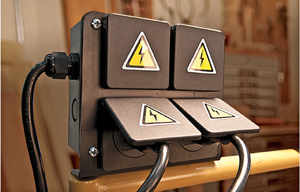
If you are rewiring your shop, or building one from scratch, should everything be 220V or can you use 110V? And is there a way to rewire old tools to handle the 220V if you go that way?
Michael Dresdner: Some of your larger tools will be 220V, while all your smaller hand tools, lights, and outlets will be 110V. Most shops, mine included, have both.
In my own shop, all wiring is in EMT pipe affixed to the walls ? not inside the walls. This allows me to change or add wiring anytime I need to and to easily follow all outlets and connections all the way back to the breaker box. I can also leave an extra unattached wire inside the tube if I suspect a 110V circuit will someday need to be a 220V.
Rick White: It only makes sense to have both 110V and 220V in your shop. It’s easy enough to wire for both and most handtools won’t work with 220V. If you’re wondering if the motor on your older tool will handle 220V, there’s almost always a plate on or near the motor that will tell you how much voltage the motor can handle. But since I’m a woodworker and not an electrician, I would strongly advocate that you talk to an electrician before you make wiring decisions. It will save you time and help you layout your workshop more efficiently.





